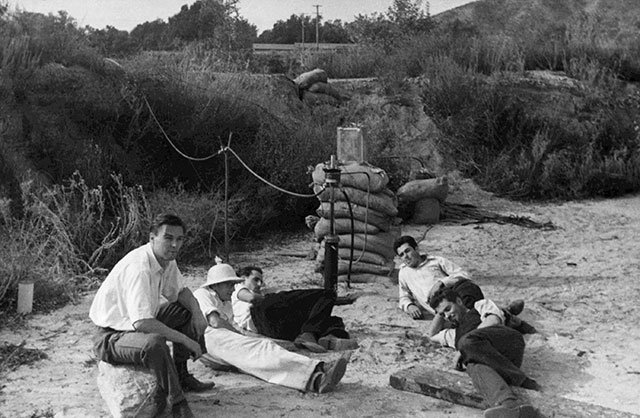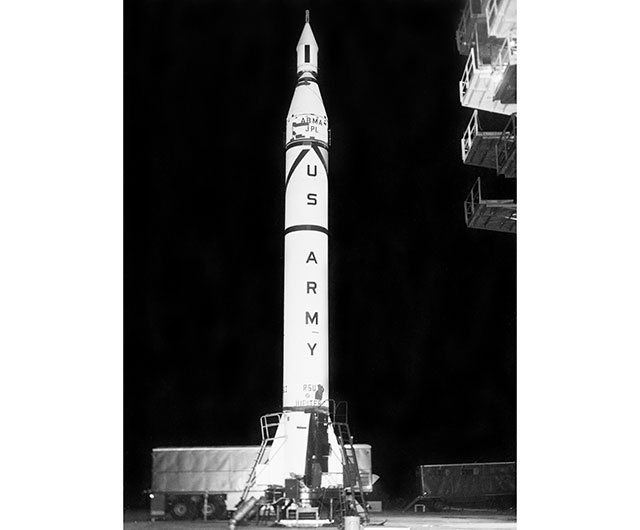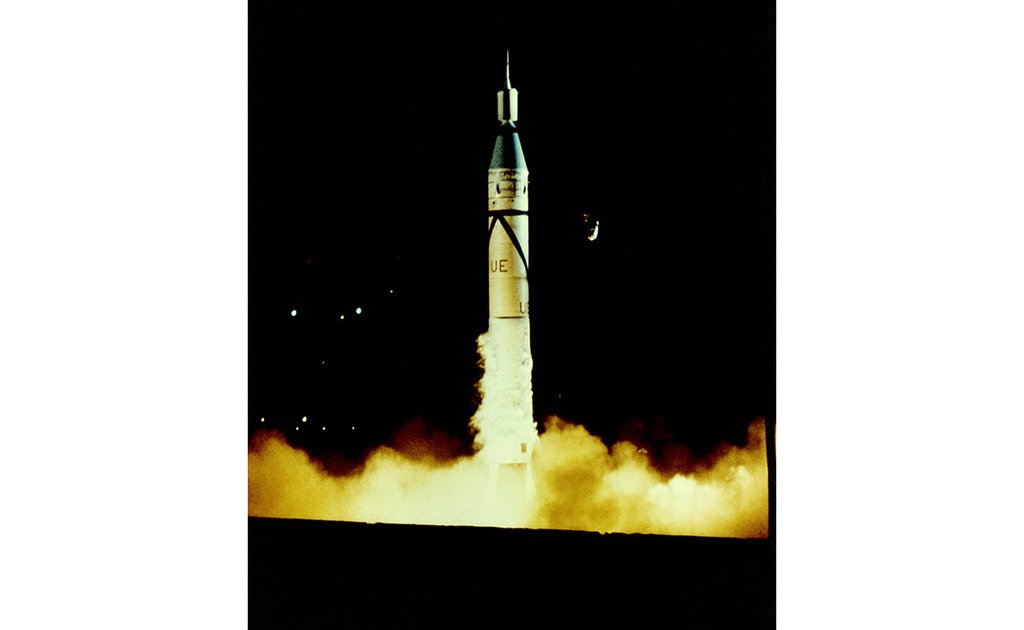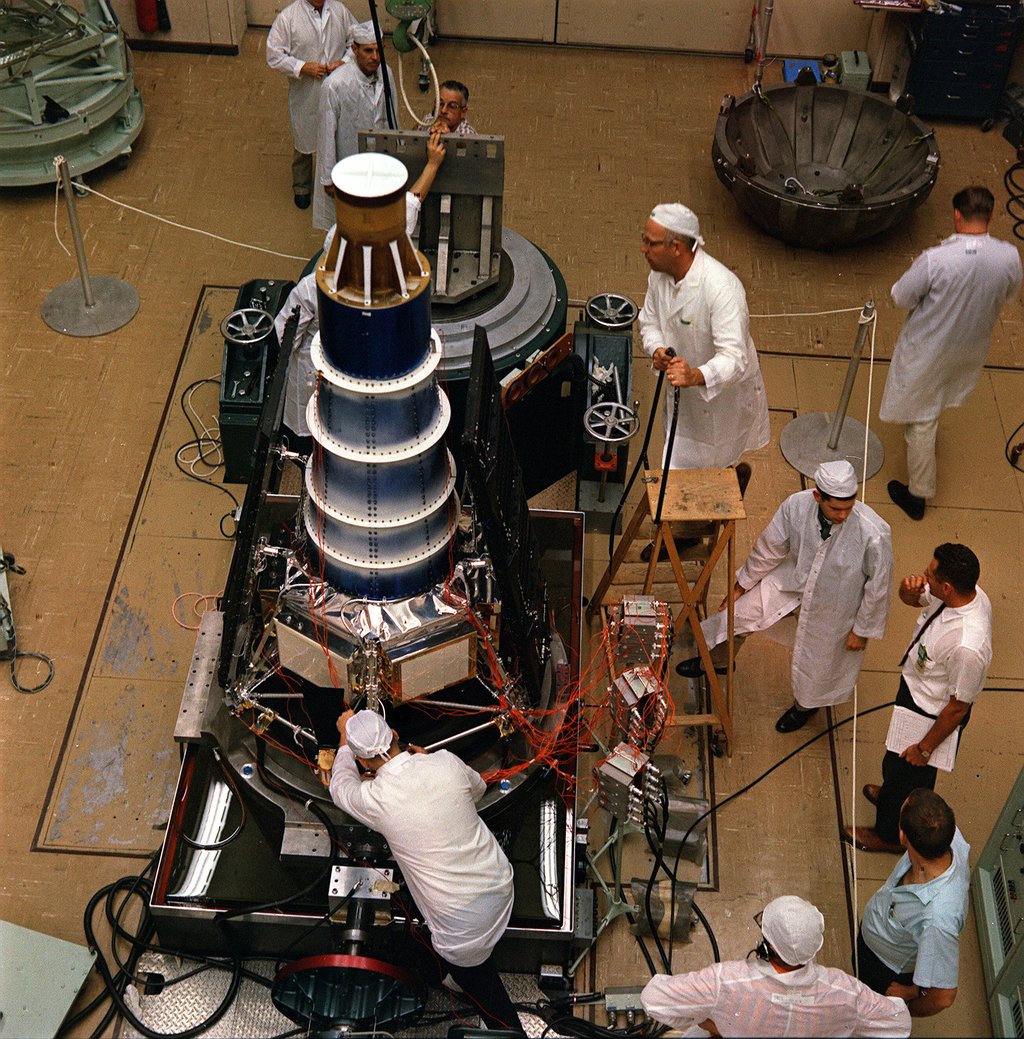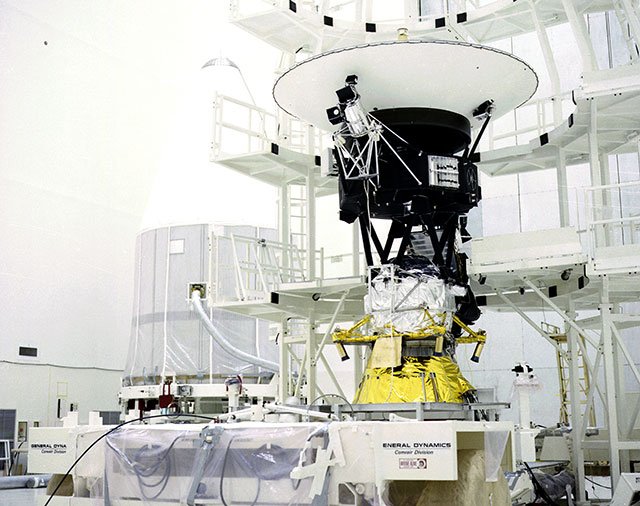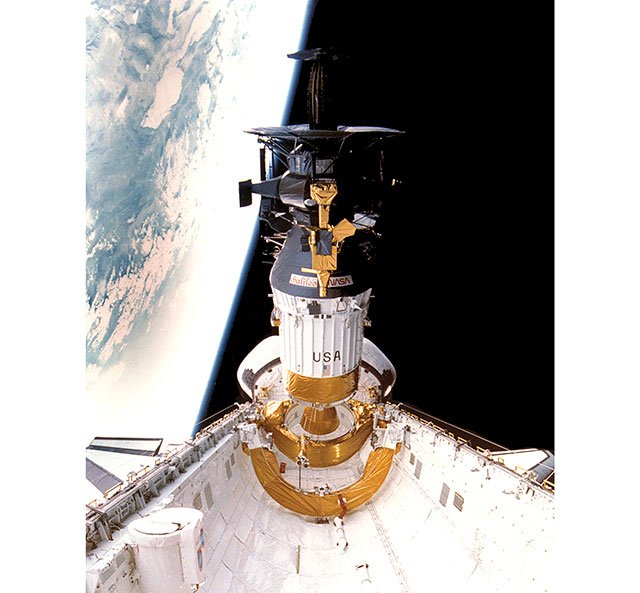History
JPL's beginnings
The origins of the Jet Propulsion Laboratory date back to the 1930s, when Caltech professor Theodore von Kármán oversaw pioneering work in rocket propulsion. After unsuccessful and sometimes hazardous experiments, several graduate students led by Frank Malina, along with rocket enthusiasts from the Pasadena area, moved their work off campus. They chose the Arroyo Seco, a dry canyon wash north of the Rose Bowl in Pasadena, California – and future home of JPL.
View a List of JPL Firsts
The Caltech group's first tests of an alcohol-fueled rocket motor in the riverbed wilderness area took place on October 31, 1936. As the group improved their rocket motors, von Kármán, who also served as a scientific adviser to the U.S. Army Air Corps, persuaded the Army to fund development of jets mounted on heavy propeller planes to assist take-off from short runways. The Army helped Caltech acquire land in the Arroyo Seco for test pits and temporary workshops. Flight tests at nearby air bases proved the concept and tested the designs. By this time, World War II had begun and demand for the motors grew.
In 1943, the Army asked von Kármán for a technical analysis of the German V-2 program discovered by Allied intelligence. He and his research team proposed a U.S. research project to understand, duplicate and improve upon the missiles beginning to bombard England. In their 1943 proposal, the Caltech team referred to their organization for the first time as "the Jet Propulsion Laboratory."
Funded by the U.S. Army’s Ordnance Corps beginning in 1944, the Jet Propulsion Laboratory's early efforts would eventually involve technologies beyond those of aerodynamics and propellant chemistry -- technologies that would evolve into tools for space flight, secure communications, spacecraft navigation and control, and planetary exploration.
From rockets to missiles
In late 1944, the team began tests near Leach Spring in the Mojave desert of small unguided missiles, named Private, that reached a range of about 11 miles (nearly 18 kilometers). By 1945, with a staff approaching 300, the group had begun to launch test vehicles from White Sands, New Mexico, to an altitude of 40 miles (60 kilometers), monitoring their performance by radio and war surplus radar equipment.
Control of the missile was the next step, requiring two-way radio as well as radar and a primitive computer (using radio tubes) at the ground station. The result was JPL's answer to the German V-2 missile. Corporal first launched in May 1947, about two years after the end of World War II in Europe.
Developing a missile that would fly and survive in the field involved testing its aerodynamic design and durability under vibration and other stresses. The team developed a supersonic wind tunnel and an array of environmental test technologies, all of which had wider use and came to support outside customers.
Developing as complex a device as a missile to fly unaided and beyond reach of repair required a new level of quality, new test techniques and a new discipline called systems engineering.
The race to space
In 1954, JPL proposed launching a satellite with Wernher von Braun's team at the Army's Redstone Arsenal in Alabama for the International Geophysical Year being planned for 1957-58. Their proposal was rejected, and instead JPLers embarked on a classified project to test nuclear warhead re-entry technology. Using a modified Redstone booster and clusters of JPL solid-fuel rockets, they flew three suborbital missions in 1956 and 1957 to prove warheads could return from space and not burn up.
After the pioneering Soviet launches of Sputnik and Sputnik 2, U.S. President Dwight Eisenhower used one of the recovered warheads as a prop to show the country's progress during a televised speech to the nation.
The technology and hardware developed for this re-entry test series led to America's first successful satellite. After the humiliating launch pad explosion of the Navy's Vanguard project launch attempt in December 1957, JPL and the Army Ballistic Missile Agency were allowed to try. They succeeded spectacularly with Explorer 1 on January 31, 1958. Explorer I went beyond Sputnik by carrying the first space experiment, a Geiger counter developed by James Van Allen, which discovered belts of trapped radiation encircling Earth.
From JPL to NASA
With Explorer I, JPL vaulted the U.S. into space and prompted the formation of NASA. On December 3, 1958, two months after NASA started operations, JPL was transferred from Army jurisdiction to that of the new civilian space agency. The laboratory brought to NASA experience in building and flying spacecraft, an extensive background in solid and liquid rocket propulsion systems, guidance, control, systems integration, broad testing capability, and expertise in telecommunications using low-power spacecraft transmitters and very sensitive Earth-based antennas and receivers. The Laboratory now covers some 168 acres (68 hectares) adjacent to the site of the early rocket experiments. It is NASA's only Federally Funded Research and Development Center, operated for the agency by Caltech.
JPL creates its niche
In the 1960s, JPL began to develop robotic spacecraft to explore other worlds. This effort began with the Ranger and Surveyor missions to the Moon, paving the way for NASA's Apollo astronaut lunar landings. Rangers 7, 8, and 9, launched in 1964 and 1965, took photos of the Moon as they descended toward intentional impacts. In 1966 through 1968, Surveyors 1, 3, 5, 6 and 7 made soft landings on the Moon.
During that same period and through the early 1970s, JPL carried out Mariner missions to Mercury, Venus and Mars. Mariner 2 became the first spacecraft to fly by another planet and return data following its launch to Venus on Aug. 27, 1962. JPL's Mariner 4 was the first successful mission to Mars, returning a handful of shocking images after a short 1965 flyby showing a cratered, Moon-like surface.
In 1971, Mariner 9 became the first spacecraft to orbit another planet, imaging almost the entire surface of Mars. Mariner 10 was the first spacecraft to use a "gravity-assist" boost from one planet to send it on to another — a key innovation in spaceflight that would later enable the exploration of outer planets that would otherwise have been unreachable. Mariner 10's launch in November 1973 delivered the spacecraft to Venus in February 1974, where a gravity-assist swingby allowed it to fly by Mercury in March and September that year.
JPL and NASA's Langley Research Center collaborated on the Viking mission to Mars, which landed biological experiments in 1976. JPL built the Mariner-derived orbiters, conducted mission communications and navigation and eventually assumed responsibility for management of the mission.
The farthest
Perhaps JPL's grandest mission is Voyager, which visited all four of the solar system's gas giants. Launched in 1977, the twin Voyager 1 and Voyager 2 spacecraft flew by the planets Jupiter (1979) and Saturn (1980–81). Voyager 2 then went on to an encounter with the planet Uranus in 1986 and a flyby of Neptune in 1989. Early in 1990, Voyager 1 turned its camera around to capture a series of images assembled into a "family portrait" of the solar system. Still communicating their findings as they speed out toward interstellar space, the Voyagers are expected to have enough power to continue communicating information about the Sun's energy field until approximately 2025. In February 1998, Voyager 1 passed NASA's Pioneer 10 to become the most distant human-made object in space. In August 2012, Voyager 1 crossed the heliopause to become the first spacecraft to enter interstellar space. Voyager 2 followed it, on Nov. 5, 2018.
To return data from its planetary missions, JPL also designed, built and operates NASA's Deep Space Network of antenna stations. These complexes are located in California's at Goldstone in the Mojave Desert, near Madrid, Spain and near Canberra, Australia, and are designed for communicating with and navigating spacecraft beyond Earth's orbit. In addition to NASA missions, the network regularly performs tracking for international interplanetary missions. The Goldstone station in California also hosts one of the country's two planetary radars.
The extinction crisis
Although the Viking and Voyager missions were great achievements in exploration, the decade of their building and launch was greatly challenging for JPL. NASA focused its declining post-Apollo budget on building the Space Shuttle, and planetary exploration funding diminished substantially. JPL embarked on an effort to broaden its research activities into non-space related areas under Department of Energy funding, exploring energy technologies but also communications and transportation. The Laboratory became involved in solar electric and solar thermal technology development, geothermal studies in western states, development of police communications technologies, fuel-cell and electric vehicles, and even people mover development.
These programs were cut in the early 1980s, and JPL turned to Defense Department work instead. The Lab's most significant development during the 1980s was for the U.S. Army: a battlefield management tool known as the All-Source Analysis System.
Indicating just how low the status of planetary exploration's status had fallen within NASA, in September 1981 the agency's administrator threatened to end planetary exploration entirely and close JPL. Supporters in the scientific community, members of Congress, and some of Caltech's trustees rallied in protest. Instead of cancellation, new planetary missions began to be funded. The first of these was the Magellan radar mission to Venus, authorized in 1983.
Throughout its near-death experience, JPL had a single planetary mission in development. The Galileo mission to Jupiter had been authorized in October 1977 for a 1982 space shuttle launch, but delays to the shuttle program, confusion over the development of an appropriate upper stage to send the probe on its way out of Earth orbit, and finally the loss of space shuttle Challenger and its crew in 1986, postponed Galileo's launch until 1989.
The atmospheric entry probe carried by Galileo was developed by NASA Ames Research Center. The probe entered the Jovian atmosphere on Dec. 7, 1995, measuring the composition of Jupiter's atmosphere until it was crushed, as expected, by extreme pressure. The Galileo orbiter lasted until September 2003, when JPL ordered it to plunge into Jupiter's atmosphere to ensure that it would not crash into, and contaminate, any of Jupiter's moons. Among other things, Galileo found a water ocean under Europa's planetary ice sheet, and possibly under two other moons as well; determined that the moon Ganymede has a magnetic field; and spotted the first asteroid moon, Dactyl, orbiting main belt asteroid 243 Ida in the main asteroid belt between Mars and Jupiter.
JPL branches out
The downturn in planetary exploration funding during the 1970s had one welcome consequence: JPL began to seek other kinds of spaceflight tasks. This led the Lab into astronomy and Earth science.
One of JPL's technology development efforts in the mid-1970s had been research on improving charge-coupled detectors (CCDs) for use in space. This work was intended for the Galileo camera system, but also resulted in the Laboratory being awarded the Hubble Space Telescope's Wide Field and Planetary Camera in 1978. Intended to be the observatory's primary imaging instrument, WFPC operated flawlessly when the telescope was finally launched in 1990.
WFPC also helped pinpoint a manufacturing flaw in the telescope's primary mirror. It had been polished to just slightly the wrong shape. The error made Hubble a hugely expensive laughing stock shortly after launch, but JPL scientists realized they could rescue the mission by installing corrective optics in an updated camera. JPL developed the camera, WFPC2, which was installed on Hubble by astronauts in 1993, and operated until removed during a servicing mission in 2009.
If WFPC was JPL's first major astronomy mission, it was far from the last. JPL was the U.S. partner on the Infrared Astronomical Satellite program, a joint effort with the U.K. and Netherlands to complete an infrared survey of the low temperature universe. Launched in 1983, IRAS operated for 10 months, mapping 96% of the sky.
The mission also established a permanent repository for infrared astronomy data, the Infrared Processing and Analysis Center (IPAC), at Caltech.
IRAS opened the door to other infrared astronomy missions, including JPL's Spitzer Space Telescope, launched in 2003 and decommissioned in January 2020.
JPL also found its first major Earth science opportunity in this era, 1978's Seasat-A mission. Seasat-A was an ocean remote-sensing satellite, with experimental instruments for measuring surface temperature, sea surface height and wind velocity. The satellite also carried a synthetic aperture radar for both ocean and land surface studies. Seasat-A failed prematurely, but all of its instruments later flew on other JPL missions, including the US/France TOPEX/Poseidon and its successors in the Jason series of ocean altimetry satellites, QuikScat and RapidScat. Spare equipment from the synthetic aperture radar experiment also flew on the second space shuttle mission in 1981.
During the 1980s, as NASA was developing its space shuttle, the agency had also begun to develop an Earth Observing System concept to advance understanding of our planet's processes. JPL won competitions for a number of instruments on the EOS Terra, Aqua, and Aura satellites, including the Atmospheric Infrared Sounder for meteorological research, and the Multi-Angle Imaging Spectroradiometer for aerosol science. Launched between 1999 and 2004, the missions were still operating as of 2019.
NASA also developed a parallel program of smaller, lower-cost missions, the Earth System Science Pathfinders. JPL entered the program with an ingenious mission to map the movement of water and melting ice by proxy, through changes in the gravitational pull of shifting masses on orbiting satellites. The Gravity Recovery and Climate Satellite (GRACE) launched in 2002 and operated until 2017. Its successor, GRACE-Follow On, launched in 2018. JPL also won a cloud research mission, CloudSat, launched in 2006, as well as a series of atmospheric carbon dioxide measuring missions, the Orbiting Carbon Observatories, and the Aquarius sea surface salinity mission. JPL's most recent ESSP mission, ECOSTRESS, was attached to the International Space Station in May 2019.
JPL has also hosted aircraft-based missions and instruments, including JPL's Oceans Melting Greenland (OMG) series of expeditions; the Airborne Microwave Observatory of Subcanopy and subsurface; the Airborne Snow Observatory; CORAL; the AVIRIS imaging spectrometer, and the UAVSAR synthetic aperture radar. Many of these missions are aimed at tracking Earth's changing climate but contribute to other needs, too. And several missions improve weather forecasts.
Planetary revival
JPL's first planetary mission approval after Galileo's in 1977 was the 1983 approval of the Magellan radar mapping mission to Venus. It was followed by approval of a series of low-cost planetary missions called "Planetary Observers," starting with Mars Observer. Like Magellan, Mars Observer was intended to fly on the space shuttle, but following the Challenger tragedy the spacecraft launched on a Titan III rocket in 1992.
While Magellan enjoyed a very successful mission to map most of Venus' surface via radar, Mars Observer disappeared shortly before it was to go into orbit around Mars. With Mars Observer went the Planetary Observer line of missions—no more were built.
Magellan's approval built momentum for the Cassini-Huygens mission to Saturn, a more complex and difficult political effort. Cassini-Huygens mission was a joint NASA-European Space Agency (ESA) mission, with NASA providing the launch vehicle and JPL-built orbiter, and ESA providing an atmosphere entry probe targeted at the Saturnian moon Titan. ESA approved the joint mission in 1988, and NASA followed in 1989. But the sudden dissolution of the Warsaw Pact and the Soviet Union over the next few years resulted in NASA's budget unexpectedly shrinking, and Congress threatened to terminate Cassini in 1992 and again in 1994. The international commitment to the mission saved it, though a budget cut forced the cancellation of Cassini's instrument scan platform – ironically increasing the mission's operating cost over its very long life.
The Cassini-Huygens mission left Earth on Oct. 15, 1997, and reached Saturn in June 2004. On its third orbit of Saturn, the orbiter released ESA's Huygens probe for its Titan descent, which occurred on Jan. 13, 2005. Huygens recorded the most distant planetary landing to date, and operated for 72 minutes on the moon's frozen surface before its batteries failed.
The Cassini orbiter continued to study Saturn, its rings and moons until Sept. 15, 2017, when its fuel ran low and the flight team crashed the spacecraft into Saturn's atmosphere to avoid contaminating moons that could harbor native microscopic life.
Cassini circled Saturn for nearly half of the giant planet's 29.5 year orbit around the Sun, studied the seasonal changes in its atmosphere during that time, and made dozens of flybys of its moons. Among its many discoveries was super-low temperature volcanism ("cryovolcanism") on the tiny moon Enceladus, with the spacecraft even flying through a plume of gas and dust to sample it. The plume contained chemicals that could fuel microbial life, exciting scientists interested in the search for life off Earth. Cassini flew through Saturn's rings and atmosphere during its final scientific campaign, returning data on their composition and structure until the moment it disintegrated.
Making tracks on Mars
Long before Cassini's end, NASA leaders had turned the loss of Mars Observer into an opportunity. They gained approval of a Mars exploration program called Mars Surveyor, and chose JPL to lead the program. The Mars Surveyor program eventually flew all of Mars Observer's experiments, though on smaller spacecraft. Mars Global Surveyor, Mars Climate Orbiter, the 2001 Mars Odyssey, and finally the Mars Reconnaissance Orbiter of 2005, all carried Mars Observer instruments. The Mars Surveyor program came to an end in 2000, after the failure of two missions launched in 1998, the Mars Climate Orbiter and the Mars Polar Lander.
Mars Observer's loss also helped enable NASA to gain approval for another planetary mission program, known as Discovery. The Discovery Program required NASA centers and university-based scientists to submit proposals to competitions that were to be held every few years. To get the program going, the first two Discovery missions were assigned. JPL was awarded Mars Pathfinder. The Mars Pathfinder mission introduced what has become a powerful technology for planetary exploration: the planetary rover. The USSR had landed robotic rovers on the Moon, and it had tried to land a miniature rover on Mars in the 1970s but had failed. Mars Pathfinder's micro-rover, named Sojourner, for abolitionist Sojourner Truth, in 1997 became the first robotic rover to explore the Red Planet.
Mars Pathfinder also pioneered a new policy of releasing imagery to the public in almost real time, via the newly public World Wide Web. Finally, Mars Pathfinder was also inexpensive, and justified an agency drive to reduce the cost of planetary missions even further.
After the failures of the Mars Climate Orbiter and Mars Polar Lander, NASA approved the Mars Exploration Rover mission, whose two rovers were named "Spirit" and "Opportunity" after their launch in July 2003. The two were equipped for robotic geology, looking for signs that liquid water having ever existed on the surface. They operated until 2010 and 2018, respectively, roving nearly nearly 33 miles (53 kilometers) between them. Among their many spectacular findings: at some time in Mars' deep past, water had flowed on the surface.
NASA also approved a large orbiter to help discover suitable landing sites for a future Mars sample return project. That orbiter mission became the Mars Reconnaissance Orbiter, launched in 2005.
The next rover, eventually named "Curiosity," was equipped for even more detailed investigation of Mars' ancient minerals and geology. It arrived on Mars on Aug. 6, 2012, and was still operating in 2020.
JPL's next rover to Mars is a modification of Curiosity and is named Perseverance. It was launched July 30, 2020. Instead of mineralogy, it will specialize in astrobiology and look specifically for signs of past life on Mars. Perseverance is also designed to collect and store rock samples on the Martian surface for retrieval by a future Mars sample return mission, formally approved by NASA in 2019. Perseverance also hosts a robotic helicopter named Ingenuity, a technology demonstration mission that will attempt powered flight on another planet.
Competing for the planets
JPL was awarded a number of other Discovery program missions after Mars Pathfinder. The Stardust mission collected particles from comet Wild-2 in 2004, while the Genesis mission returned some particles from the solar wind in 2004. The Deep Impact mission launched a kinetic impactor at Comet Tempel 1 to assess its structure and composition in 2005. The GRAIL mission, based on the GRACE gravity satellites, produced very high resolution gravity maps of the Moon, while the Dawn mission used solar-electric propulsion to visit the dwarf planet Ceres and the largest main belt asteroid, Vesta. JPL also managed the development of Ames Research Center's Kepler exoplanet astronomy mission, launched in 2009. The Laboratory's most recent Discovery program mission, InSight, landed on Mars Nov. 26, 2018. Its mission was to measure martian seismic activity and the heat flow coming from Mars' interior. JPL's next Discovery mission, Psyche, is being designed to explore the unusual main belt asteroid 16 Psyche during the late 2020s.
NASA used the successes of the Discovery program to initiate another program of competed missions, New Frontiers, focused on larger, higher cost efforts. JPL has managed the development of one New Frontiers project, the Juno mission to Jupiter. Unlike Galileo, which had focused much of its data gathering on the Jovian moons, Juno was focused solely on Jupiter. Juno entered a polar orbit on July 4, 2016, and was still operating in 2020.
Technology development
In the decades it has led the nation's planetary exploration program, JPL has honed several skills and areas of innovation, including deep space navigation and communication, digital image processing, imaging systems, intelligent automated systems, instrument technology, microelectronics and more.
JPL spacecraft have featured digital imaging since its Mariner IV mission to Mars. Digital compression algorithms JPL used to help return Galileo data from Jupiter are widely used in digital recording and transmission now. A JPL researcher developed the CMOS-based imaging sensor used in many cell phone cameras. A JPL spacecraft, Deep Space 1, demonstrated the use of solar electric propulsion for interplanetary missions as well as autonomous space navigation. FINDER, a radar instrument developed at JPL, has been used to find people trapped by natural disasters.
The Laboratory has also been active in developing CubeSat technology to reduce mission costs. Its first planetary CubeSats, MarCO 1 and 2, were launched with the InSight mission to Mars and provided data relay services during the probe's landing.
